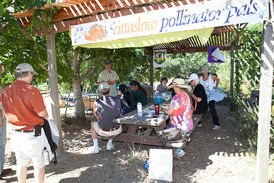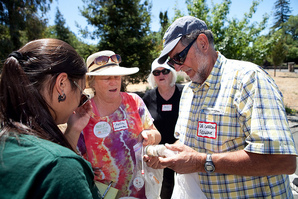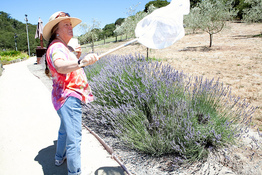Sonoma Bee Count (2011-2022)

Photo by Chere Pafford.
Two citizen groups in the city of Sonoma (Citaslow and Sonoma Ecology Center), Sonoma Co., CA contacted the UC Berkeley Urban Bee Lab in 2010 to inquire if there was interest in a collaboration to conduct a periodic count of native bees in the city. The groups were motivated by wanting to know about native bees and if the city had diverse species, and whether the counts could some day provide useful information on climate change. After a few meetings, all parties came to an agreement to conduct the count over a period of at least 10 years in a manner similar to the Christmas bird count or the annual butterfly counts, that is, one day each year. Further, 9-10 local volunteer citizens would make the count with the mentoring of personnel from the Berkeley bee lab. The first counts were started during a weekend in June 2011 and involved a 6-hr Saturday meeting for background info and instruction, and the following Sunday for the field count. The count that year from 3 subsites in the city, using a standard monitoring method (pan traps and aerial collections off flowers) yielded 32 species. Citizen satisfaction was high based on a questionnaire administered to the participants at the end of the day. The last count was conducted in June 2022, concluding the ten years of collection (there was no Sonoma Bee Count conducting in 2020 due to the Covid-19 outbreak).

Photo by Chere Pafford.
In 2012, the count was condensed into a one-day event based on comments from 2011. The count was tailored into a project-based learning experience. It started at 8:30 am with an hour of background info and an agenda for bee monitoring with the 10 citizens who had volunteered ( 2 were repeats from 2011). It lasted all day using the same 3 sites and methods with collecting, counting, and processing
bees for later identification. A total of 39 species were collected in the second year! Once again citizen satisfaction was high. The total number of species collected in the first 2 years is 51!
bees for later identification. A total of 39 species were collected in the second year! Once again citizen satisfaction was high. The total number of species collected in the first 2 years is 51!

Photo by Chere Pafford.
Take home lessons from the two years of counts were: citizens can do these counts effectively if they are carefully mentored by professionals. Identification of bees to the species level necessitates the attention of a bee taxonomist; in this case Dr. Robbin Thorp at UC Davis. Results of the counts are of a quality that can be published in a peer-reviewed journal. Citizens enjoyed bee collecting and receiving bee stories from the mentors as they worked in the field and indoors when they processed the bees. They also commented on their satisfaction from doing something new in science and for the city.
